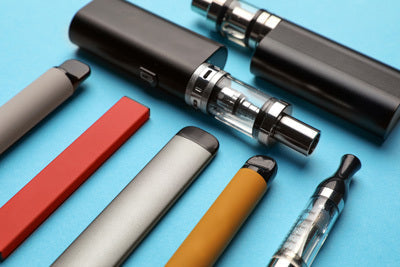
Even if you’re an experienced vaper who bought your first vape kit long ago, you may have never paused to think about what’s happening when you vape and what effects it has on your body. After all, cigarettes are so simple that you probably never thought too much about how they worked when you sat down to smoke.
A vaping device, however, is much more complex than a cigarette. When you combine the complexity of vaping hardware with the equally complex pharmacokinetics of nicotine, there’s quite a lot happening inside and outside your body when you vape.
So, how does vaping work – and what are the effects that vaping has on your body? In this article, we’ll provide an overview that’ll help you understand what’s happening. This is your introduction to the science behind vaping.
The Principles Behind Vaping
The history of vaping is a fascinating subject that we cover in detail elsewhere on this site. In short, though, the idea of safe, portable personal vaporisers that people could use to deliver compounds directly to their lungs is roughly a century old at least. The first patent application for a personal vaporiser was filed in the United States in 1927, and the patent was granted in 1930. Over the following decades, many inventors would attempt to create devices that allowed people to inhale vapour instead of cigarette smoke. Those early attempts were unsuccessful, though, because the required technologies weren’t quite ready yet.
In the 2000s, new technologies such as lithium-ion batteries and tiny integrated circuits finally made it possible to make vaping a reality – and that’s when the modern e-cigarette was born.
Throughout the development of what would eventually become vaping, the main principles were always the same:
- It’s preferable to deliver a substance to the lungs as vapour rather than smoke.
- If the act of using a personal vaporiser is pleasurable and satisfying, people might use vaping to wean themselves off of cigarettes.
- The main way to make vaping as pleasurable and satisfying as it can be is by making nicotine a component of the vapour.
How Your Vaping Device Works
With that introduction out of the way, let’s examine how a modern vaping device works and learn more about what happens when you use your vape. There are many different types of vapes today ranging from small disposable vapes to large vape mods, but they’re essentially the same in how they operate.
- The battery provides the required power to the circuit board and heating coil.
- The circuit board and firmware control the device’s functions. A button or airflow sensor is attached to the circuit board, and that’s how you use the device – either by inhaling or by holding a fire button. The circuit board may also be outfitted with other sensors – such as a temperature sensor and a battery monitor – to ensure that the device won’t operate in unsafe conditions.
- The heating coil is made from a metal or alloy with high electrical resistance. The coil generates heat when it resists the current flowing through it, and the heat vaporises the e-liquid held in the coil’s wick.
- The wick brings more e-liquid to the coil after you puff on the device.
- The reservoir holds your device’s supply of vape juice. In a disposable vape, the reservoir is usually a large wick that holds all of the device’s e-liquid. Other devices store their e-liquid in plastic or glass cartridges, pods or tanks. When the reservoir is empty, you need to add more e-liquid or install a new cartridge or pod. When a disposable vape is empty, you need to replace the entire device.
What Happens to Your Body When You Vape?
There are two ways to inhale when you vape. You can draw the vapour directly into your lungs, or you can hold the vapour in your mouth before inhaling it. You’re most likely to use the latter inhaling technique – called the mouth-to-lung or MTL technique – if you’re new to vaping because that’s how you’d smoke a cigarette.
When you vape, you’ll feel three things. The first thing that you’ll feel is a throat hit, which is the mild irritation that nicotine causes in your throat when you inhale it. Although throat hit is a form of irritation, many former smokers who switch to vaping greatly enjoy it because throat hit helps vaping to feel as close to smoking as possible.

The next thing that you’ll feel when you vape is the absorption of nicotine through your lungs. Just like the throat hit, the lung hit that you feel when vaping is very similar to the sensation that you’d feel when inhaling cigarette smoke. Between the throat hit and the lung hit, vaping feels much more like smoking than any other form of nicotine replacement.
The final thing you’ll feel when you vape is the effect of the nicotine itself. It’s been said that people who are addicted to nicotine only feel completely normal immediately after using it, and a nicotine user’s mood can turn sour rapidly after a significant amount of time without nicotine. If you haven’t vaped in a while, you’ll probably notice that your mood improves rapidly after you vape. You may also feel an energetic buzz from the nicotine. After a few puffs, you’ll notice that you no longer crave nicotine and no longer feel tempted to smoke a cigarette. At that point, you can put your device down for a while.
Does Vaping Have Any Negative Side Effects?
Vaping is the most pleasurable and satisfying form of nicotine replacement, and a study conducted by Public Health England concluded that vaping reduces the health risk of smoking by around 95 percent. No form of nicotine use is completely safe, though, and vaping does have some potential side effects that you should be aware of before you begin. Those side effects include:
- Coughing: It’s normal to cough when you first quit smoking. If the coughing persists, your device’s power level may be set too high.
- Sore throat: If you experience a sore throat when vaping, you should make sure that you’re drinking plenty of water. If the issue persists, you should consider switching to an e-liquid with a lower nicotine strength.
- Dehydration: The main components of vape juice are vegetable glycerine and propylene glycol, and both of those ingredients are humectants. When you vape, you should always drink plenty of water to keep yourself hydrated.
